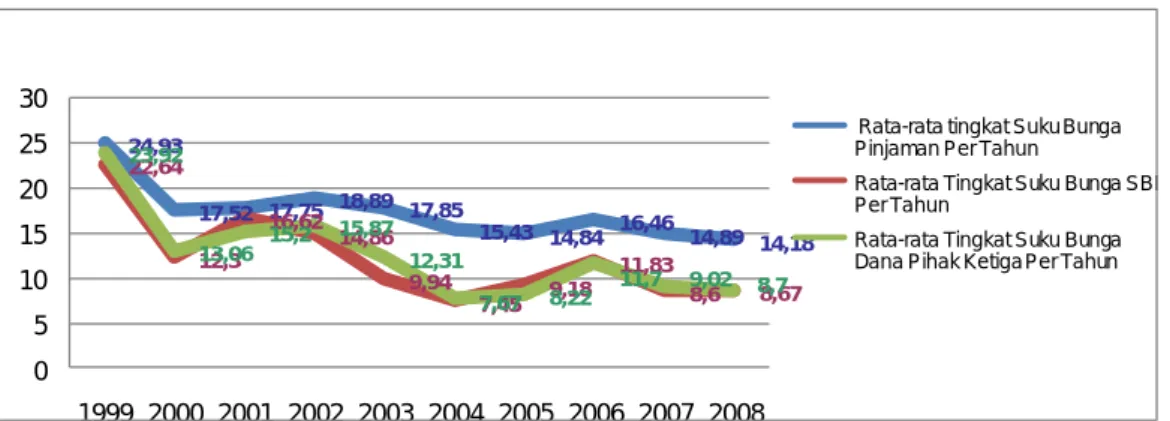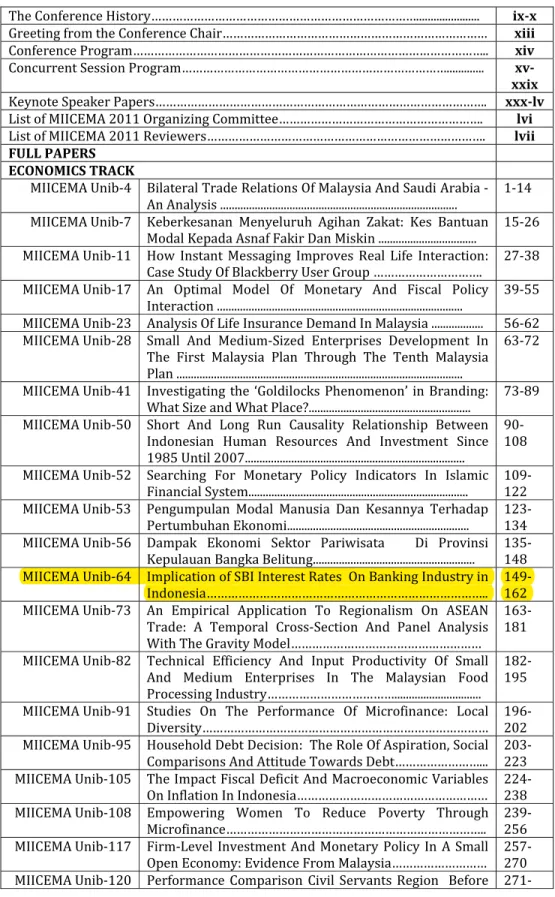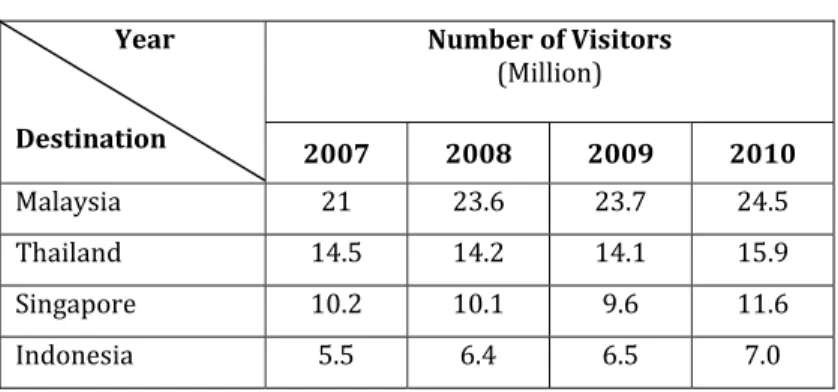Greeting from the Rector
First of all, I would like to express my deepest gratitude to God for giving us His blessing to successfully organize the 12th Malaysia-Indonesia International Conference on Economics, Management and Accounting 2011. I would like to express my gratitude to the Universiti Kebangsaan Malaysia, Universitas Syiah Kuala Banda Aceh,. In the future, some other universities will join this conference as co-organizers.
The main purpose of holding this seminar is to exchange ideas and information and to promote understanding and cooperation between participants from different countries. The theme of this conference is "Borderless Economy: Opportunities, Challenges for Business in Southeast Asia." This theme is highly suitable for helping regional development to ensure the success of business in the region. Last but not least, my greatest appreciation goes to everyone who contributed to the success of this conference, especially the presenters, participants, sponsors, organizer and its committee members.
To our special guests from Malaysia, Thailand, United Kingdom, Iran, India and Australia, I hope you have a pleasant stay in Bengkulu, the home of Rafflesia Arnoldi.
Greeting from the Conference Chair
Conference Program
Concurrent Program
Unib-68 Identifies the earnings management of the company listed on the Index LQ 45 on the Indonesian Stock Exchange. Unib-127 Review of the Outsourcing Controversy in Indonesia: An Exploratory Study on the Human Resources Outsourcing Controversy in Semarang City. Unib-22 The Effect of Capital Structure on Profitability: The Comprehensive Analysis of Biotechnology Companies Listed on Bursa Malaysia.
Unib‐87 The effect of consumer materialism behavior on the consumer's decision to purchase private label products. Unib‐82 Technical Efficiency and Input Productivity of Small and Medium Enterprises in the Malaysian Food Processing Industry.
Keynote Speech Papers
Rizal A. Djaafara Director of Center for Central Banking Education and Studies
Nowadays, the flow of capital has been one of the main concerns of emerging market economies ever since. This situation is fueling fears of speculative bubbles in the region's capital markets. Therefore, the stability of the financial system in ASEAN countries remains manageable and the economic recovery of the region will continue.
Until the early 1990s, most banks had only national operational activities, after which the globalization of the banking sector grew rapidly, including to emerging countries. The globalization of the banking sector can take the form of cross-border ownership, operations and market shares. The globalization of the banking industry certainly has several positive impacts on the banking industry in each country.
These can take the form of long-term capital inflows, improving intermediary capacity and promoting better competitiveness and efficiency of the banking industry through the implementation of international best practices, knowledge and technology transfer. In the heart of Southeast Asia lies one of the most luxurious countries in the world - Malaysia. Today, the travel and tourism industry, with 1.4 million jobs, represents 4.1 percent of jobs in the economy.
We are all aware that tourism is a long-established economic activity in Southeast Asia, dating back to the early nineteenth and twentieth centuries, although mass tourism is a relatively new phenomenon that largely began in the 1970s. Let's take a look at the tourism industry in Malaysia with regards to INTRA-ASEAN Travel. So far in 2010, there is rapid growth in the tourism industry, a reflection of the region's thriving and diversified economies.
When we talk about people's interest and impressions, we somehow also relate to the kind of tourism we want to offer to the people. In light of the increasingly competitive situation in the Southeast Asia region, traditional methods of marketing a destination to the masses have given way to more focused marketing segmentation strategies and thematic campaigns.

OVERSEAS MARKETING
- Strengthening the Thailand Brand
- Expanding the Quality Tourist Market
- Protecting the Leisure Tourist Market Base
- Increasing Thailand’s Potential and Competitiveness
Page xlii three main aspects which were overseas marketing, domestic marketing and marketing support. The objective was to increase the number of high-end tourists by strengthening awareness of medical tourism, honeymoon attractions and wedding venues, filming locations, souvenir shopping and golf courses, among the target market. Actors, producers and directors from Korea, India and Hong Kong were invited to Thailand to spend their holidays and inspect the country's readiness.
TAT encouraged Thai tourism operators to participate in worldwide events; such as Quality Travel Fair 2010 in Copenhagen, Denmark, World Medical Tourism & Global Health Congress in the USA. The aim was to secure Thailand's market share in Asia by maintaining the existing customer base (repeaters) and at the same time expanding into a new market (first-time visitors). The goal was to increase the effectiveness of TAT and its alliances to compete in the global market by developing an effective online system and using modern media.
1672 Tourist Hotline Video Call Center” online at www.tourismthailand.org, in addition to a telephone inquiry. Tourists can contact the staff directly for tourist information online via a "Live Chat" system in both Thai and English.
DOMESTIC MARKETING
- Promoting Linkage Tourism
- Campaigning for Tourism with Awareness in Its Value and Preserving Tourist Attractions
- Promoting Tourism in the Dimension of Learning
To create an attitude among Thai people that tourism is part of their lives and to encourage Thais to travel more for tourism. Page xlvi To create a clear picture of each area so that tourists can see the differences between the areas and be more interested in traveling there. Tourists from other regions participating in the program were brought to the southern part of Thailand.
To raise awareness of preserving the environment (nature, history and culture) and encourage Thais to be good hosts and tourists. Page xlvii Thai and foreign divers, garbage collection at Pak Meng beach by 242 local villagers and students.
SUPPORT FOR THE MARKETING OPERATIONS
- Promoting Tourism Products and Services That Support the Thailand Brand
- Promoting and Creating Tourism Activities. Important operations included
- Developing the Databases
- Increasing the Organization’s Potential
A number of factors are responsible for the rapid growth and development of the tourism industry in the Asia-Pacific region. This includes the strong economic growth so that we can provide funds for the improvement of infrastructure, accommodation and other utilities that must be affordable, this can increase the number of tourists; breaking down political barriers - politics affects tourism especially when certain country creates barriers from another country, therefore we need to build good relations and cooperation with each SEA countries; easing travel restrictions as much as possible to welcome more tourists; liberalization of air transportation for easy travel can also boost increase in tourism industry including cheaper cause of flights, of course it can attract many visitors and travelers; focused marketing campaigns, this may include several. There has been a remarkable increase of advertisements related to leisure and tourism activities in both print and electronic media over the past year.
Such strong symbolic messages spread through the mass media have certainly contributed to a change in attitudes towards work, leisure and tourism. The Internet is also the most suitable medium for gathering information from tourists, in 2008 more than 50 percent of tourists gathered information online. For affluent consumers, shopping has become a popular leisure activity not only in their own country but also abroad.
FACTORS AND STRATEGIES TO CONSIDER FOR FURTHER DEVELOPMENT OF TOURISM INDUSTRY IN SOUTH EAST ASIAN COUNTRIES. By carefully studying what is currently happening and what is planned for the near future, we may be able to predict something about tourism some distance ahead. Page l One of the best strategies is to promote INTRA-ASEAN TRAVEL; this will require cooperation and participation among Southeast Asian countries.
INTRA‐ASEAN travel was the main source market for the region with a share of 47 percent in 2010. This strategic plan will contribute to the overall goals of the ASEAN community by 2015 by promoting the growth, integration and competitiveness of the tourism sector and while at the same time deepening social and cultural understanding as well as facilitating travel within and within ASEAN. Various tourism sectors are trying to host millions of foreign visitors at present, as well as attract foreign direct investment for the development of the industry during this period.
2006 Benchmarking and Quality Assurance in Technical Education: Sharing Experiences Rajamangala University of Technology Srivijaya. 1976: Head, Department of Audio Visual Education, Institute of Technology and Vocational Education (ITVE), South Campus.
List of MIICEMA 2011 Organizing Comittee
List of MIICEMA 2011 Reviewers
- Are there any influence of the Interest Rate Interest Rate SBI against third-party funds?
- Are there any influence on the SBI Interest Rate against the Average Interest Rate Loan Banks?
- Are there any influence of the Interest Rate third party Fund against a third-party Fund volumes?
- Are there any third-party Fund volume influence on the Volume of Distribution of Commercial Bank loans?
- Are there any influence of the Average of Loan Interest Rate against the Volume of Distribution of Commercial Bank loans?
- Are there any influence of third-party Volume Funds and the Average of Loan Interest Rate against the Volume of Distribution of Commercial Bank loans? Partially and
- To evaluate the influence of the SBI Interest Rate to the third party fund Interest Rate
- To evaluate the effects of SBI Interest Rate to the Average Interest Rate Loan
- To evaluate the influence of the Interest Rate on third-party funds to the volume of third- party funds
- To evaluate the influence of third-party funds Volume to the Volume of Distribution of Commercial Bank loans
- To evaluate the influence of the Average Interest Rate Loan to to the Volume of Distribution of Commercial Bank loans
- To evaluate the influence of the volume of third-party funds and the Average Interest Rate Loan to the Volume of Distribution of Commercial Bank loans, Partially and
- The nature of business and market segments in the bank itself
- Financial position as its capital adequacy ratio, risk-weighted assets, legal lending limit
- The ability to raise funds, especially third-party funds
- The quality of productive assets, especially credit quality
- The factors of production are available at banks such as management ability and level of bank profits
- The interest rate on current bank
- The perception of the bank against the debtor
- Inflation and economic growth
- The need of funds, factors specific to the needs of fund of funds, namely how much funding requirements desired
- Target desired profit
- Policies, in determining the deposit rate the bank can not arbitrarily set the interest rate exceeds the limit deposit insurance rates are set by the government because it means
- SBI Interest Rate (X), the interest rate of Bank Indonesia Certificates (SBI) is the interest rate securities issued by Bank Indonesia in recognition of short-term debt (1-3
- Interest Rate Third party funds (Y1) is the cost of funds that must be issued by banks for every dollar funds has been taken. Funds raised from public funds in this study is
- Loan Interest Rate (Y2) is the interest rate used for lending or credit or interest rates charged by conventional banks to the borrower (debtor) of the loan has been provided
- The volume of lending (Z) is the number of bank facilities granted to the parties to use the funding deficit that has been collected by the banks of the surplus public
- Banks are not delisted during the study period
- Publish financial statements in the period 1999-2008
- The Influence of the SBI interest rate against Interest Rate Average on Bank’s Loan The correlation between the SBI interest rate against Interest Rate Average on
- The Effect of Interest Rate Funds on the volume of third-party third-party funds Correlation between Third party funds Interest Rate by third-party fund volume
- Volume Effect Against Third Party Fund Distribution Volume of Credit The correlation between the volume of third-party funds with a volume of
- Effect of Interest Rate Loans Average Volume Distribution Against Commercial
- Effect of The volume of third-party Funds and the Interest Rate Bank’s Loan Average Against the Volume Distribution of Credit
- The interest rate on Bank Indonesia Certificates have a positive and significant influence on interest rate deposits
- SBI interest rate has a positive and significant impact on interest rates average loan bank’s
- The interest rate on third-party funds has significant and negative effect on the volume of third-party funds
- The third party funds volume have positive and significant impact on the volume of lending
- Lending rates of commercial banks on average have negative and significant effect on the volume of lending
- Simultaneously, the volume of third party funds and lending rates of commercial banks on average have a positive and significant impact on the volume of lending
Third, both the volume of third-party funds and the interest rate on borrowing for commercial banks influence the volume of loans. Is there any impact of interest rate SBI towards third party funds. To evaluate the influence of the interest rate on third-party funds to the amount of third-party funds.
To evaluate the influence of third-party funds Volume to the distribution volume of commercial bank loans. The amount of third party funds (Y3) is the amount of funds raised by banks and from the community (Abdullah, 2005). The average amount of third-party funds per year = Average of Σ (Giro + savings + deposits + certificates of deposit) per year.
H3 = There was a significant effect between interest rate funds on the volume of third party funds. H4 = There was a significant effect between the volume of third party funds on the Loan Volume Distribution. This suggests that the increase in rates will cause the interest rate of third party funds to increase.
This suggests that the increase in the third-party fund interest rate causes a decrease in the volume of third-party funds. This means that interest rates a third party funds negatively affect the volume of third party funds. Effect of the volume of third party funds and the interest rate bank's loan average against the volume spread of credit.
The volume of third-party funds has a positive and significant impact on the volume of lending. And finally, the volume of third-party funds and credit interest rates greatly affect the volume of lending.


